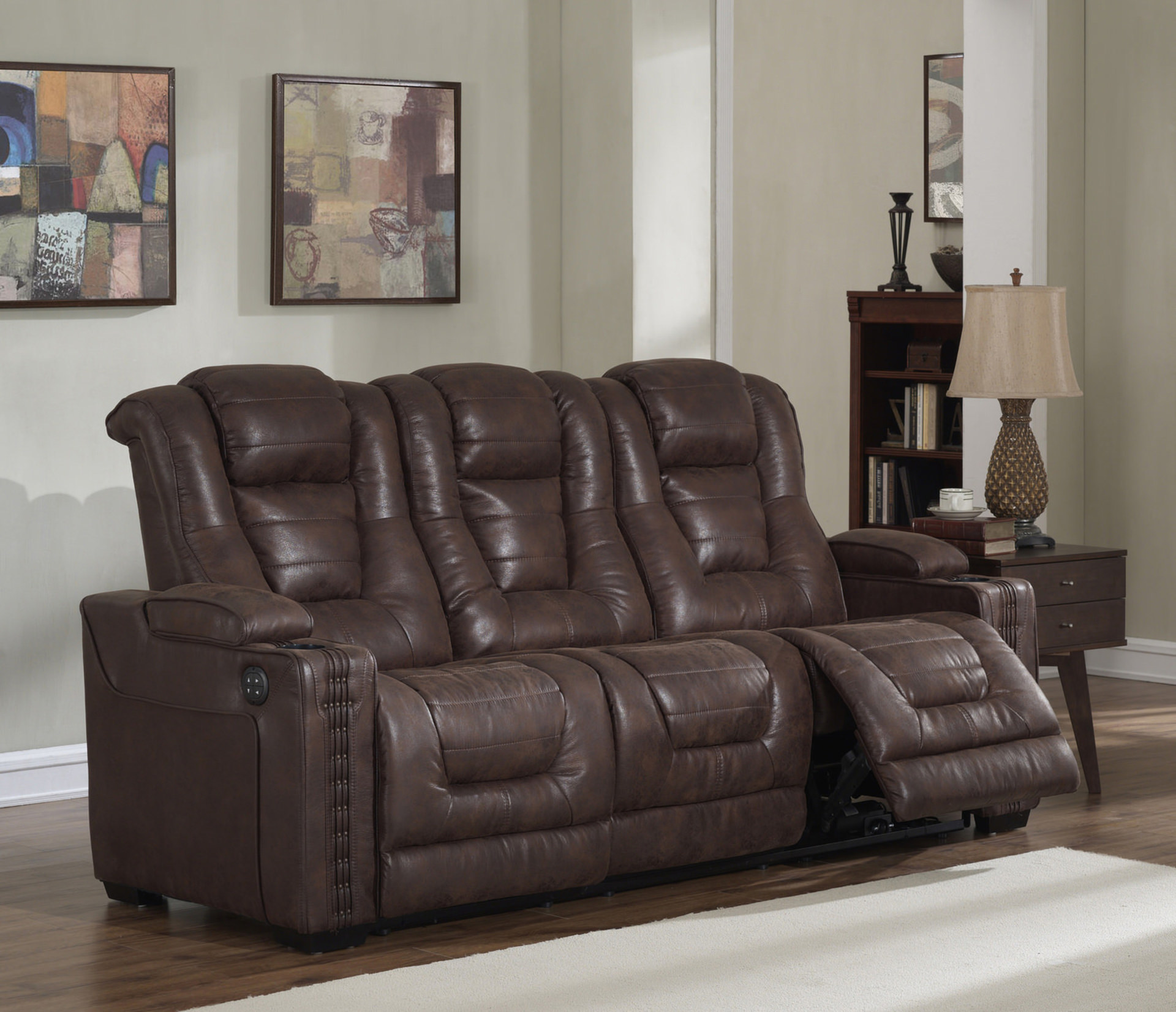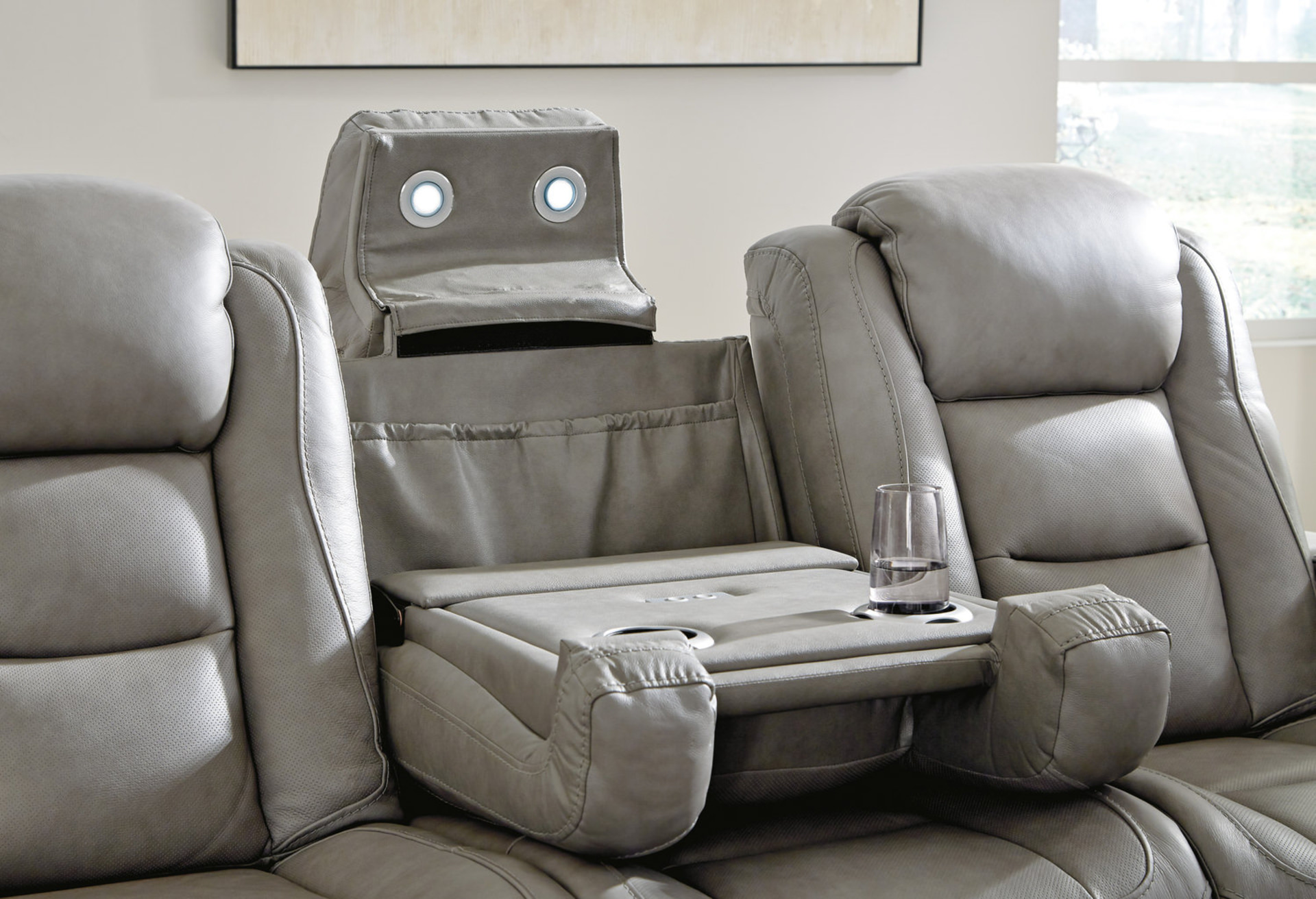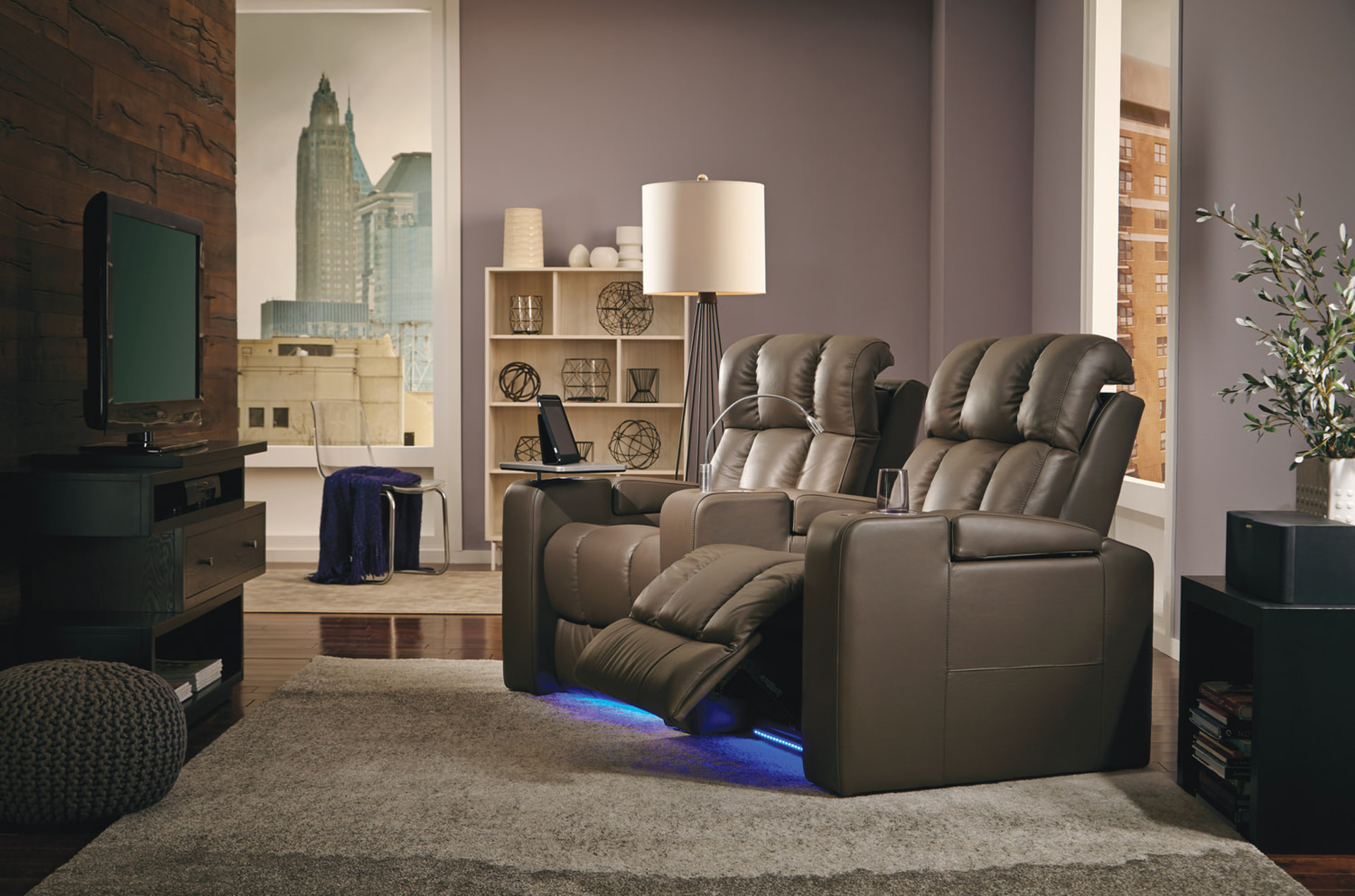Home Theater Seating Buying Guide

Do you love movie night at home? Great films are fun on almost any TV, but a big screen with home theater seating takes the experience to another level. Add some popcorn, and it’s like having your very own movie theater.
It’s no wonder that the popularity of home theaters and media rooms are soaring. A home entertainment center not only provides night after night of enjoyment but can even enhance a home’s resale value. A big key to the quality of the viewing experience: how good is the seating? Luxurious entertainment room seating can make your family and guests so comfortable that they think they’re at a real movie house. Or, if you’re watching a big game, they’ll feel like they’re sitting in the VIP suite.
Here are some ideas to consider when you shop for seating for your home theater.
Seating to Support Your Chosen Style
Home theater rooms come in a variety of shapes, colors and configurations. Some look as much as possible like an actual cinema house, while others take on a homier ambiance. Some home theater spaces are used almost exclusively for viewing, while others might be reconfigurable to create a multipurpose space.
When people think of home theaters, what often comes to mind is an alignment of large, dark leather chairs and sofas. That’s a traditional style that makes for excellent viewing, and many folks prefer it, but it’s far from the only choice.
It’s possible to give a home theater a casual or rustic feel instead of a more formal one. You could go with the modern look of black leather pieces with minimal lines. You could also adopt a more relaxed ambiance with soft, rustic seats, perhaps with plush armrests. You can even set up a room that bypasses traditional theater seating entirely, instead deploying items such as sectionals and smaller fabric recliners.
You might even consider unexpected colors, perhaps to match decor such as sports-themed or movie-themed wall art. You can use theater seating to set up a room in a classic movie seating style, or you might channel your creative juices into a room that supports great viewing but also provides a little of the unexpected.

Sit Back and Relax
Most movies are at least two hours long, so everyone needs a seat that starts out comfortable and stays comfortable. Modern cinema seats recline, and most home theater seating does as well. That way, no matter where in the room you’re sitting, you can adjust to realize the most comfort and an ideal view of the action.
Individual reclining chairs are a popular choice, but there are alternatives that might make better use of the space. For example, some two-piece and three-piece sofas have a smaller per-person footprint but still let each viewer recline individually. Reclining love seats are a popular choice. There are even sectionals that have some reclining capability.
Typical theater seating is generously sized, sturdily built, well-padded and uncompromisingly comfortable.
Unleashing the Power
Most home theater recliners are power recliners, and the electronics do more than just push the seat back and move it forward again. Power recline technology continues to evolve and to find more and better ways to ensure maximum comfort with minimum effort. Whether it’s overall body position, neck and head support or extra consideration for your lower back, modern recliners make it simple to touch a few buttons and get yourself situated any way that pleases you.
Here are some features you might want to include in your checklist when you shop for home theater seating:
- Independent footrest. Some footrests automatically move as you recline, but there are separately controlled footrests where you can pick your own leg position no matter the angle of the backrest.
- Adjustable headrest. The headrest doesn’t necessarily have to move in lockstep with the seat back. A power adjustable headrest allows you to independently choose your level of head and neck support.
- Lumbar adjustment. No matter what the curve of your lower back or how you like it supported, a power lumbar support gives you your choice of back position. Some people will vary lumbar support during a long viewing session to keep their backs comfortable.
- Lay flat mechanism. Recliners vary in how far back they’ll take you, and some go all the way flat. You probably won’t choose full horizontal while the show is running, but it’s nice to have if you like to slip into your theater room for some relaxation or even a nap.
- Easy-reach buttons. If you have several power features, you’ll have more than one button, and you’ll want to make each adjustment with a simple push of a finger.
- Memory buttons. If you find the cushy position that you want to come back to again and again, a memory feature stores it and retrieves that ideal spot with a single button push.

Leather and More
When people think of home theater upholstery, they think first of leather, and with good reason. Few things match the beauty and durability of leather, and it’s a classic look for recliners and similar pieces. Top grain leather, from the top layer of the hide, is the gold standard. There are many grades of leather to choose from. All are long lasting and low maintenance.
Another option is leather-look polyester fabric. This material is also quite durable, and it’s often available in more colors. Another choice is a leather-synthetic hybrid that features leather everywhere a person touches it.
Of course, there’s no rule that you have to have leather-look furniture at all. Colors and patterns in performance fabric are all fair game for a home theater area. These can be especially versatile in a room that isn’t going to be a home theater 100 percent of the time.
Comfortable and Durable Construction
Look beyond the upholstery to ensure that you’re choosing items that not only are comfortable but will remain comfortable for a long time. Quality constructions means you can enjoy movies, TV shows and sports hour after hour and year after year in seating that makes ongoing viewing a pleasure. Look for well-padded hardwood frames and heavy-duty recliner mechanisms.
The Extras That Make a Difference
Every recliner reclines. Many of them offer adjustable headrests, footrests and lumbar support. But it’s those extra touches that make theater seating into versatile furniture and takes the convenience level up a notch.
Available amenities include cup holders, USB ports, memory foam seats, LED lighting and electrical outlets in the armrests. There can be tray tables and tablet holders. Hidden storage, often in the armrests, keeps your viewing area free from disarray. Some sofas even have side-mounted Bluetooth speakers. It’s a joy to settle into an evening of binge viewing when everything you need is at your fingertips.

Seating Alternatives
If you have a big media room used almost exclusively for TV watching, you’re likely to favor classic cinema-style seating with large recliners and ample multi-seat reclining sofas. However, if you have a smaller room or a room you also want to use for other purposes, a homier configuration might suit better. Also, if family viewing with children is on your agenda, you’ll probably want at least some seats that aren’t roomy recliners.
This smaller, more flexible room might have less emphasis on leather and more on upholstered fabric seating. There could be sectionals and furniture that can be rearranged, possibly including smaller manual reclining chairs. Another possibility is to anchor the viewing arena with a dominant reclining sofa but fill in with more versatile pieces. Or you could start with a pair of hefty reclining chairs and offer additional seating that works either for viewing or for conversation.
Positioning Your Seating
When you and your guests settle in for a relaxing TV session, you want people sitting where the viewing is easy on the eyes and the audio is crisp and lively. Bear in mind that the best sound will usually be found in the center of the room. While your room size and shape affects your furniture configuration, the best audio experience comes with space around the seating area rather than pieces pushed against the wall.
Different people will want to sit at different distances from the screen, but a good rule of thumb is to fit most seats at a distance that’s 1.5 to 2.5 times the screen’s diagonal measurement. For example, if you’re watching a 62-inch TV, the ideal spots are going to be about 7 ½ to 13 feet away.
Finishing Touches
While attached trays and cup holders provide room for many of your foods and beverages, you may need a little more surface space when you start passing around napkins, popcorn and other snacks. A few well-placed side tables or sofa tables will ensure that everyone has enough room to lay everything out. These can be occasional tables that make their appearance only when they’re needed.
Also, an entertainment center or media console not only keeps electronics organized but also provides a place to display some pleasing decor. You might use a hutch-style center that actually holds the TV on a stand or a couple of ladder bookcases on either side of a wall-mounted unit.
So, if you’ve been thinking of converting your rec room into a home theater, there are plenty of seating options for doing just that. With today’s reclining chairs, loveseats, sofas and other theater seating, there’s no time like now to create the viewing space you’ve always wanted.